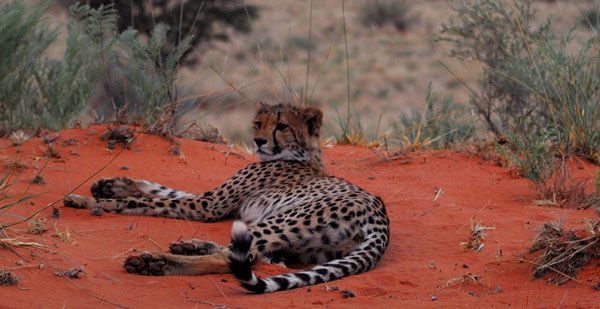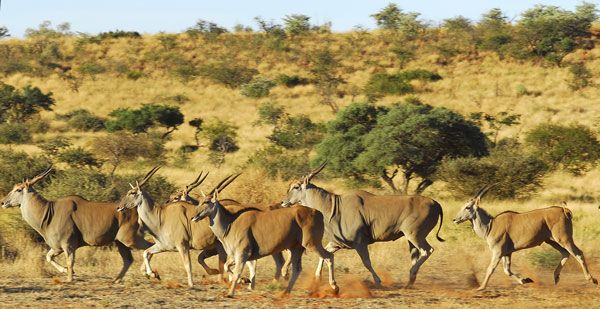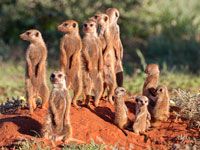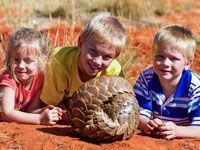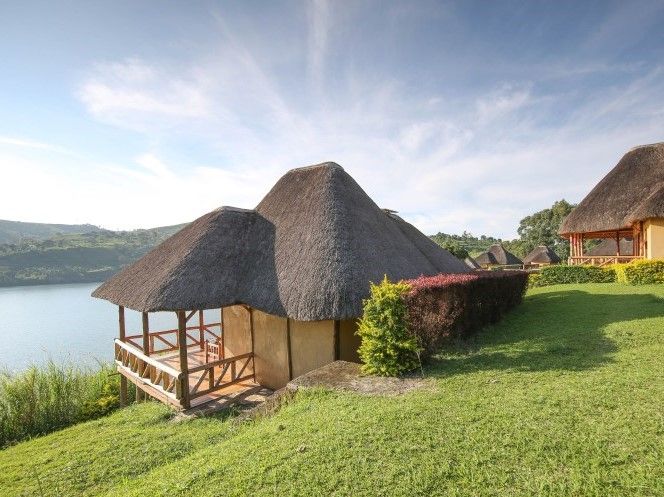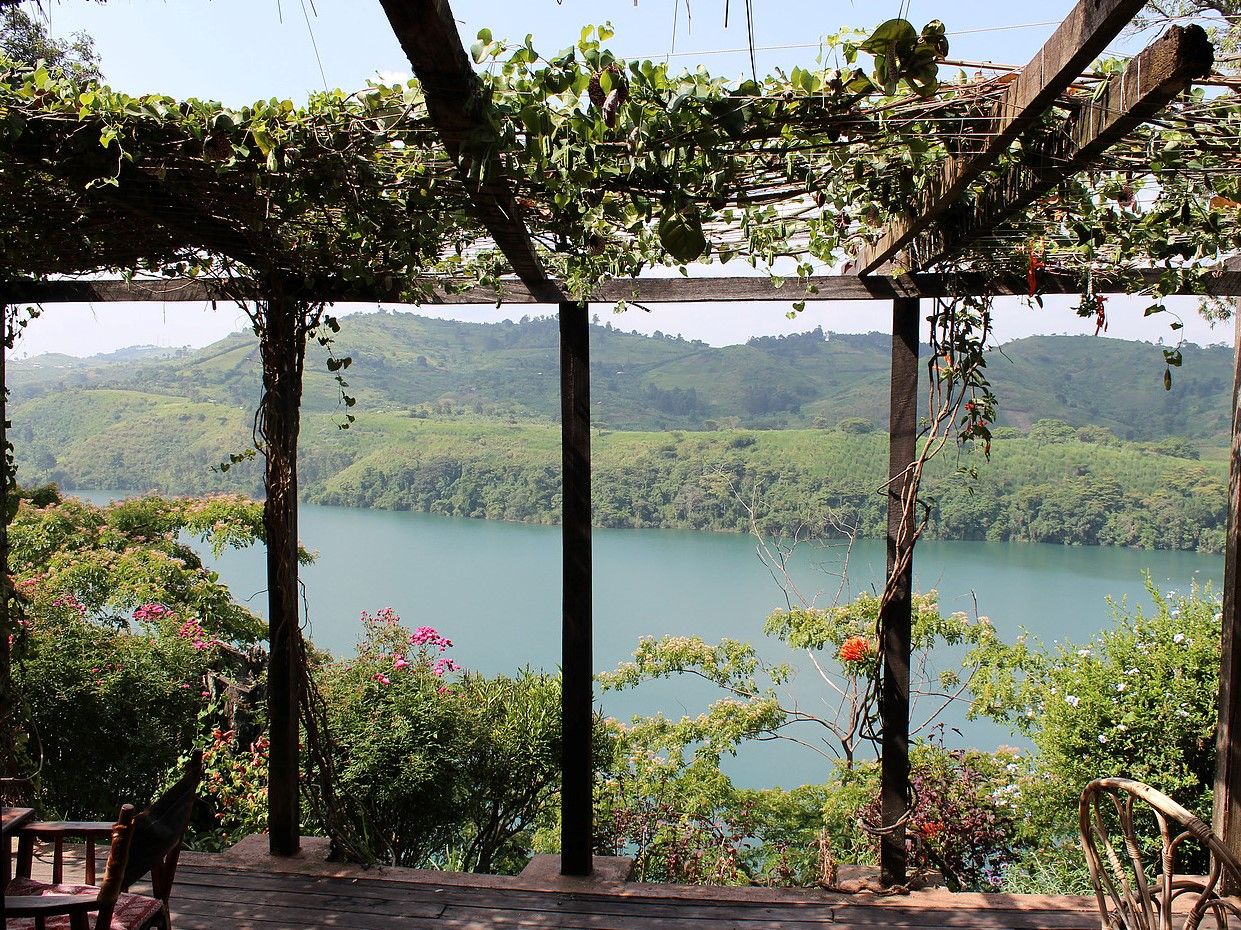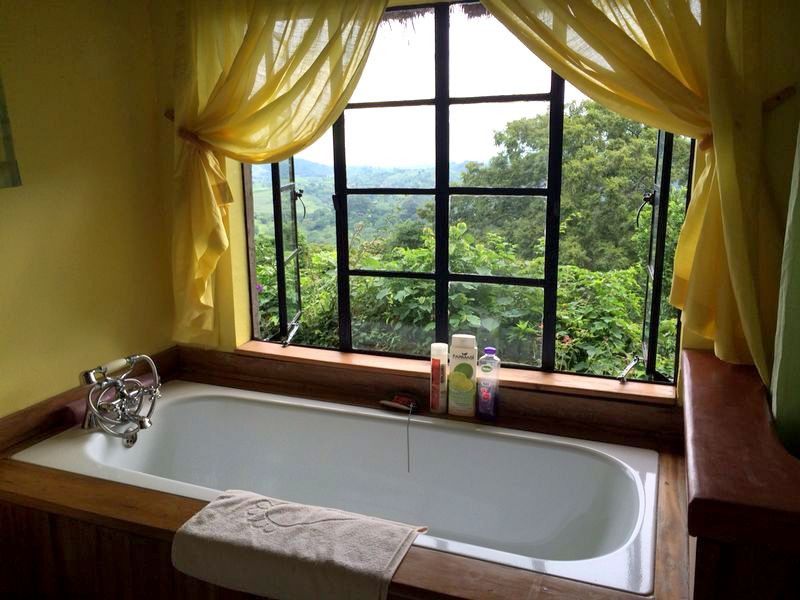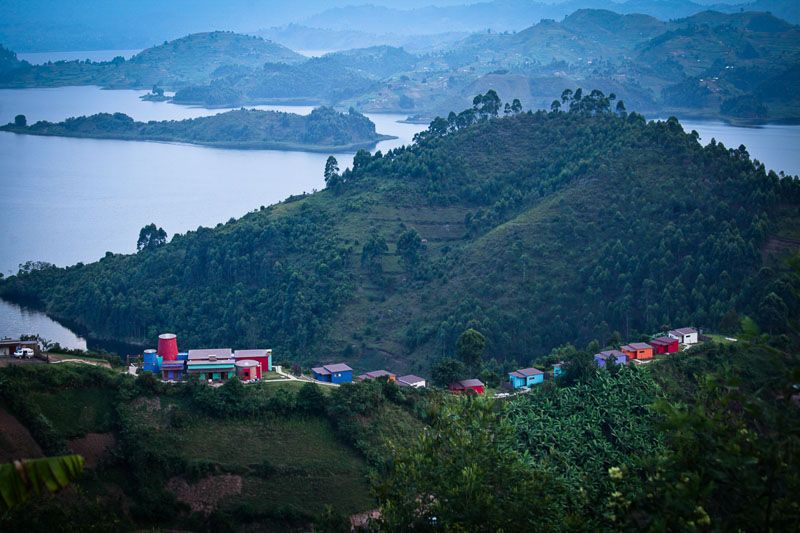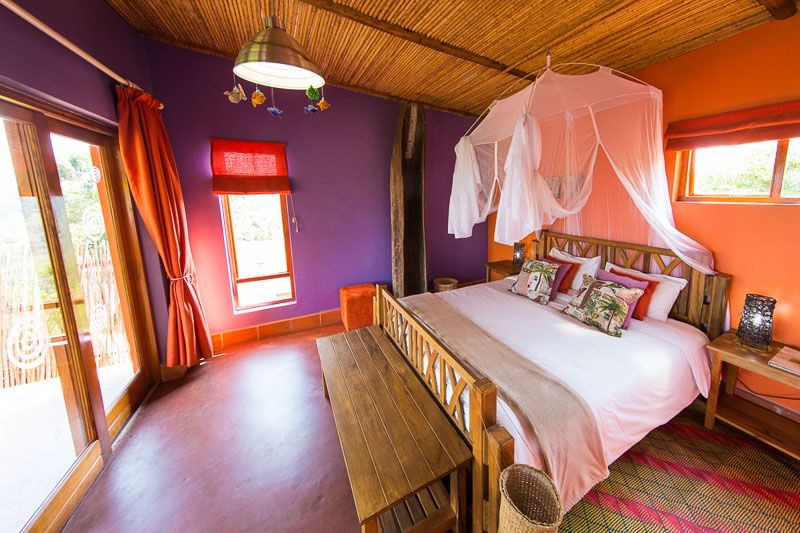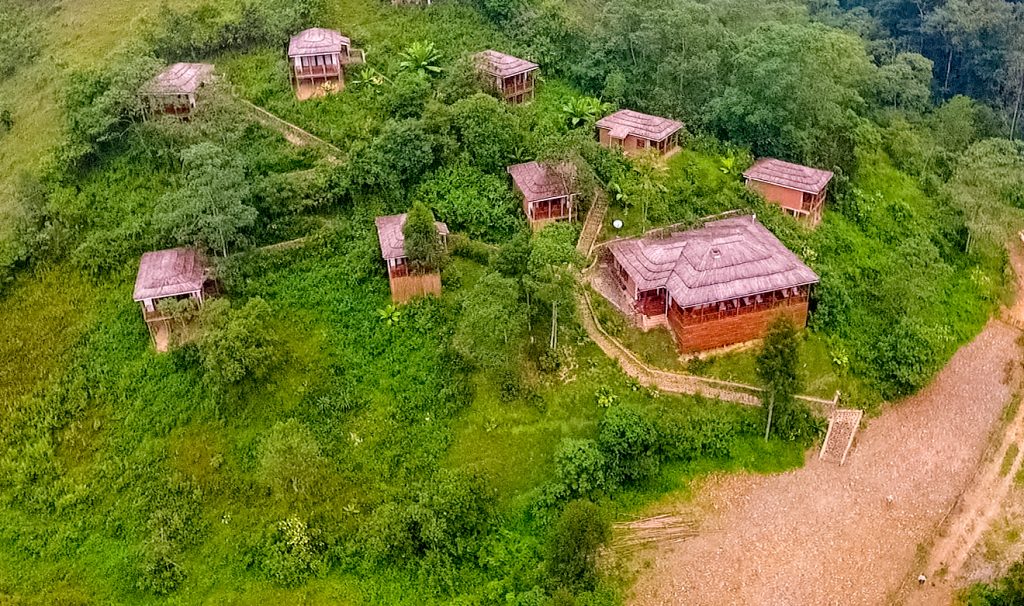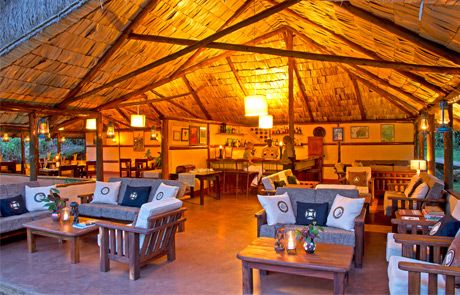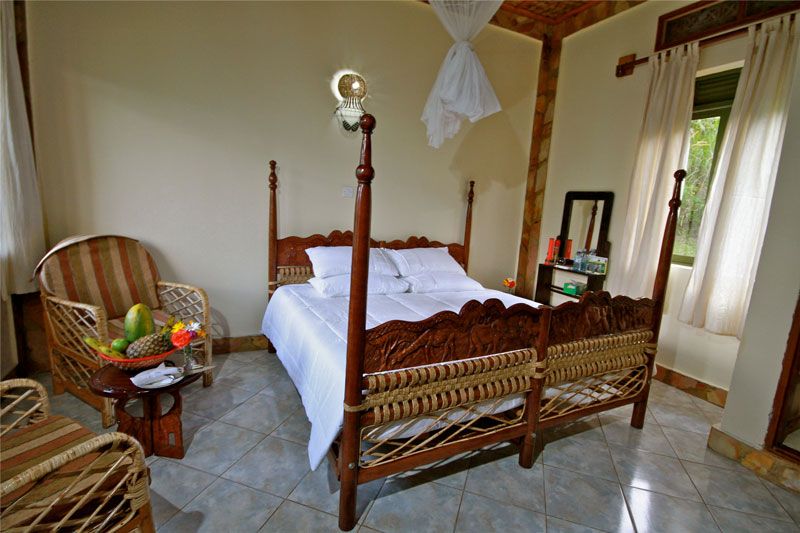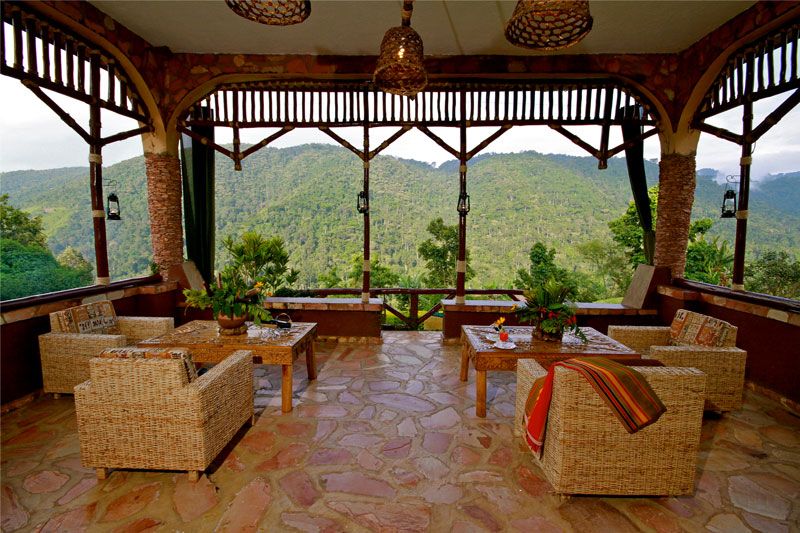With 12 rooms, it is the largest lodge in the area and remains one of the best value properties in the region, whilst keeping the Marasa Africa standards of comfort and hospitality.
South Africa
with Uganda: 14 Days of Insider's Africa: Meerkats, Gorillas & Africa's Rare 5
$16,998/person on Group Departures
4 person minimum
$17,298/person to Go On Your Own
2 person minimum
Pricing based on Motse Suite. Add $2,900/person for Loapi 1 bedroom. Call for Multi-Bedroom Family Suite Options
* Add $2,000 per person for luxury lodging at all lodges in Uganda if staying in Bwindi Sector B. Call for pricing of additional Accommodation Options
* Domestic flights required of ~$2,398/person. Note: domestic flight pricing does not include the international flight needed between the South Africa and Uganda segments.
Pricing based on 19.5 USD/ZAR exchange rate as of Dec 2023
Exchange rates are subject to change without notice, and additional currency equalization fees may be required at the time Wild Planet pays for local services, which may occur up until 30 days prior to departure – even if you have already made your final payment.

A Little More Info
SINGLE SUPPLEMENT
Single travelers staying in a room by themselves will be charged this additional single supplement fee, as all of our regular prices are otherwise based on double occupancy.
SINGLE SHARE OPTIONS (if available)
If you are traveling alone and wish to share a room, we will make every effort to find you a roommate of the same gender, in which case you will not have to pay the single supplement fee. The single supplement will be charged until we are able to confirm a roommate for you. If we are able to match you with a roommate, the single supplement will be refunded. In the event that we cannot find a share for you, you will be required to pay the single supplement fee.
New: Click the Singles Find a Share' icon below or check our "Community" page to connect with other single travelers looking to share.
South Africa
with Uganda: 14 Days of Insider's Africa: Meerkats, Gorillas & Africa's Rare 5
This is the ideal second safari to Africa for travelers who have already seen the “Big 5”. We start in Uganda with Gorilla trekking, where in typical Wild Planet Adventures’ style we’ve made special arrangements to spend 2-4 times the traditional amount of time in intimate contact with Gorillas, guided by scientific researchers, plus safaris for Chimpanzees, tree-climbing lions, mongoose and more. We continue to South Africa and a convenient stop at a very remote private reserve in the little-known savannah of the “Green Kalahari” for Meerkats, Pangolin (scaly Anteater), Aardwolf, Aardvark, and Cheetah, the best place to see some of Africa’s rarest animals. This is an incredibly unusual combination of truly “once-in-a-lifetime” safaris that feature scientific researcher-led up-close wildlife interactions for Meerkats, Gorillas, Chimps and Africa’s Rare 5.
with Uganda: 14 Days of Insider's Africa: Meerkats, Gorillas & Africa's Rare 5
Detailed Itinerary
DAY 1 Uganda - Entebbe
Arrive Entebbe airport, meet our staff and transfer to your nearby hotel. Our staff will brief you about all the Uganda activities.
Uganda is home to the highest concentrations of primates on earth, including the majestic mountain gorilla, one of the rarest animals on the planet. Only 840 mountain gorillas remain, of which at least 60% are in Bwindi Impenetrable Forest. Wild Planet’s exclusive Ultimate Gorilla & Chimp safari allows you to spend the most possible time with Gorillas of any tour operator. Contribute to Chimpanzee habituation in Kibale, join research teams in Queen Elizabeth N.P tracking lions and mongoose; and in a Wild Planet Exclusive, join expert wildlife researchers in the habituation of endangered mountain gorillas in the lush Bwindi Impenetrable Forest, an intimate Gorilla experience that allows you to spend 4x the amount of time with the gorillas than any other Gorilla trekking experience! Also enjoy guided night walking safaris in Kibale National Park, (home to over 12 primates species), plus tree climbing lions, the famous Mountains of the Moon and more!
DAY 2 Entebbe - Kibale National Park, Night Forest Walk
After breakfast we’ll drive west towards Fort Portal and to Kibale Forest National Park. Traveling on both asphalt and unpaved roads, we’ll pass through traditional Ugandan Villages where you’ll see people tending traditional crops of millet, sorghum, beans and maize. The lush rolling hills give way to the foothills of the Rwenzori Mountains, a famous tea plantation region. A carpet of green spreads before us as far as the eye can see, in contrast to the countryside through which we have just passed. We arrive at Fort Portal, then continue toward Kibale Forest, one of the great African rainforest research reserves. This evening enjoy a guided night walk in the forest to spot nocturnal animals.
Driving distance: 5 ½ hours. Overnight at Kyaninga Lodge (upscale) or Primate Lodge Kibale (mid-range) (B, L, D)
DAY 3 Kibale – Chimpanzee Habituation Experience
Today we’ll accompany Kibale’s researchers in a once-in-a-lifetime opportunity to contribute to a “soft” habituation project with chimpanzees. You’ll learn to safely observe the chimps during their daily activities, so they get comfortable with human presence without changing their natural behaviors. You will be able to experience the chimp families as they wake up, hunt, patrol, play, fight, copulate, and breastfeed. Guided by biologists and researchers, we will enjoy unprecedented intimate access to these wild chimps for the entire day until they build their nests at bed time.
Kibale Forest hosts at least 1,500 chimpanzees out of the 4,950 found in Uganda, making this the largest concentration of chimps in Africa. The park is also home to 10 other primates including diurnal species like the Red Colobus Monkey, Blue Monkey, Red-tailed monkey, Gray Checked Mangabeys, and Vervet Monkey, as well as many other animals.
Overnight at Kyaninga Lodge (upscale) or Primate Lodge Kibale (mid-range) (B, L, D)
DAY 4 Mountains Of The Moon, Queen Elizabeth National Park, Mongoose Tracking
At 09:00 AM, we begin our drive to Queen Elizabeth National Park, enjoying the majestic views en route of the snow-capped 16,000-foot Rwenzori Mountains - the famed "Mountains of the Moon".
Queen Elizabeth National Park holds huge concentrations of wildlife including predators such as the famous tree-climbing Lions, Leopard, Serval cats and Spotted hyena. Other mammals include elephant, cape buffalo, hippo, a variety of antelope, warthog, giant forest hog and 10 species of primates including vervet monkeys, black and white colobus and olive baboon. The park’s bird species number more than 600, amongst the highest in Africa. There are also several soda lakes filling ancient volcanic calderas where flamingos reside seasonally.
In the afternoon we’ll join a research team from the Uganda Wildlife Authority to track banded mongoose, a highly social mongoose which are closely related to the better-known meerkat. As the research team embark on their daily monitoring activities, you are awarded plenty of time to observe the mongoose troupes as they normally go about life. See how they engage teamwork, hunt prey and defend each other. Observe family/group hierarchy among other amazingly interesting mongoose behaviors.
Like meerkats, each mongoose group or family sleeps together in a communal underground den, changing between den sites every 3-5 days. They emerge at sunrise and forage together in the morning and afternoon before returning to the den at sunset. Take as many photos as you wish before heading back to the lodge.
Overnight at Mweya Safari Lodge (deluxe rooms for upscale and standard rooms for mid-range) (B, L, D)
DAY 5 Queen Elizabeth National Park – Jeep Safari, Lion Tracking, Boat Safari
See a different face of the park as we venture off road with a research team to track lions and contribute to a valuable lion research project in the Ishasha Sector. The researchers' Landcruiser is fitted with radio-collar-receiving equipment. You get a full briefing on the animals with opportunity for as much lion photography as you can manage.
After a leisurely lunch on the Mweya Peninsula we’ll enjoy a two-hour boat safari along the Kazinga Channel. This affords the opportunity to view wildlife up close: hippo’s huff and spray and buffalo linger in the shallows. The shores of the channel are also home to an array of birds including pink backed pelicans, pied and malachite kingfishers, saddle billed stork and many others.
Meals Included today: Breakfast, Lunch and Dinner.
DAY 6 Queen Elizabeth / Ishasha – Tree Climbing Lions / Bwindi Impenetrable Forest
After breakfast we drive further south through stunning savannah grasslands as we head to the southern sector of the park – Ishasha. This is the best area to see the famous tree-climbing lions draped from low hanging limbs of fig trees. Next we visit the Kob Mating Ground—a defined area specifically used by these stunning antelopes for challenging other males, enticing females and mating. Finally we’ll pass through beautiful savannah grasslands as we head towards the breathtaking Bwindi Impenetrable Forest National Park.
While most of today's forests are no more than 12,000 years old, Bwindi's vegetation has been weaving itself into tangles for over 25,000 years, in the process accumulating a lengthy species list. This includes 310 species of butterflies, 51 reptiles, 200 trees, 88 moths and an exceptional 120 species of mammals including 10 primates. The latter includes chimpanzee, L'Hoest's, red tailed and blue monkey, black and white colobus, baboon, and Bwindi's most famous resident, the mountain gorilla. Bwindi is a prime destination for birdwatchers. Its 350 species include seven which are IUCN red data listed and 90% of all Albertine rift endemics – species which are difficult or impossible to see in any other part of East Africa.
If staying in sector A - Overnight at Sanctuary Gorilla Forest Camp (Upscale) or Silverback Lodge (Mid-range)
If staying in sector B - Overnight at Clouds Mountain Lodge (Upscale) or Chameleon Hill Lodge (Mid-range)
(B, L, D)
DAY 7 Gorilla Tracking Bwindi Impenetrable Forest
Wild Planet Exclusive!
Researcher-Led Gorilla Habituation Project – 4 Hour Permit by Special Arrangement!
We have an early morning entry into the mountain gorillas’ sanctuary. The rainforest is spectacular, and heavily vegetated with dense landscapes crisscrossed by numerous animal trails, allowing access for trekkers. This park is best known for the fascinating gorillas, where the time taken and terrain varies according to the movements of these fantastic apes.
Our intimate gorilla experience allows you to accompany the Uganda Wildlife Authority’s Bwindi gorilla habituation team for the entire day, allowing you to have a minimum 4 hours in the presence of a mountain gorilla family – since regular permits only allow 1 hour, this is 4 times the amount of time spent up close with Gorillas – more than any other safari operator! During this time you will be able to experience the gorilla family as they wake up, hunt, patrol, play, fight, copulate, and breastfeed until they build their nests at bed time.
The thrill of spending time with and observing these gentle giants is a rare and moving adventure that will leave you with long lasting memories. Spending more time with them than the norm means you are assured of the best possible experience, with 4 full hours for better photography, researcher access for more questions, and enough time to experience more intimate and unusual behaviors. The gorillas are shy and peaceful animals and it is an unforgettable experience to watch and photograph them as they interact with each other.
The walking can sometimes be tough and long, but when you catch a glimpse of the magnificent silverback, any discomforts will be quickly forgotten. Once the gorillas are sighted, you will be guided to within 6 meters of the gorillas, and be able to sit all around them while gazing into their big round eyes as the researchers note health, behavior and other characteristics.
DAY 8 Bwindi - Entebbe - South Africa
Your driver will transfer you to Kihihi or Kisoro Airport early morning after breakfast to catch your 90 minutes flight to Entebbe, where you will connect to an afternoon flight to Johannesburg in South Africa. Arrive JoBurg and transfer to nearby hotel for overnight.
DAY 9 Arrive Tswalu – Meet Wildlife Researchers, Track Lion & Cheetah, Night Safari
Morning pickup at hotel and transfer by private pressurized plane to Tswalu.
Start your adventure in the remote "Green" Kalahari, where Wild Planet has arranged a special safari program in coordination with Tswalu wildlife experts, designed to maximize the possibility of sightings of rare animals not often seen. However, your daily activities at Tswalu, are 100% flexible to suit your desires, and all safari activities are available to Wild Planet travelers, including game drives, walking safaris, horseback safaris, and more. Archeological walks, a high-end spa, pool, gym, yoga and gourmet meals make this a truly luxurious safari experience.
Depending on your arrival time you’ll meet with your guide and resident wildlife researchers to assure that your every desire is accommodated. Begin with a game drive to see black rhino, giraffe, zebra and more before we turn our focus to big cats. We’ll track black-maned lion and cheetah, specifically seeking out hunting behaviors. It is classic cheetah behavior to make their way to elevated points to survey the surrounding areas for prey. This gives us a fantastic opportunity to photograph them in the brilliant Kalahari light.
This evening enjoy a nocturnal safari for nocturnal animals. At night the Green Kalahari comes alive. Animals that are hard to spot during the day are more visible. A favorite are the brilliant chameleons that glow an unmistakable color when lit by spotlight.
DAY 10 Meerkats Africa’s Rare 5
This morning walk to a meerkat colony and watch these extraordinarily adorable mammals warm themselves in the sunshine before they scamper off to forage. Tswalu is famous for its 2 thriving habituated meerkat colonies, so we can get up close without fear of them running away. The ever-playful pups always keep us entertained and there are constantly new pups to be seen. Meerkats and their pups share a very close bond with lots of cuddles!
In addition to the adorable pups, the meerkat sentinels can be exciting to watch. A meerkat sentinel takes on the role of ‘lookout’, watching for possible predators and other potential threats to the community while the others are foraging. After some foraging around the burrow they began grooming each other before heading down for the night. We usually watch them for at least 45 minutes from the time they come out of the burrows to the time the go foraging for the day. We have habituators to advise our guides when the Meerkats awaken, which is usually between 9:00 and 11:00am between May and Sept.
After spending the morning with the Meerkats, we’ll spend most of the day on safari for rare animals, including pangolin, aardvark, aardwolf and more. While night remains ideal to see these elusive creatures, during winter months of May – Sept nocturnal animals hunt and forage during the day so you can often see them with ideal light conditions for photos. 2015 was a record year for pangolin sightings, which are otherwise known as scaly anteaters. From May to Sept these unusual creatures become crepuscular, which means they are active early in the mornings and late in the afternoons. Although Pangolin are usually considered to be one of the rarest animals in Africa, Tswalu is undoubtedly the best place to see them. Similarly, the equally rare aardvark and aardwolf are regularly seen at Tswalu because of this unique phenomenon that occurs from May to Sept when nocturnal animals hunt and forage during the day to avoid the cold.
DAY 11 Meerkats & Big Cats
After a second morning delighted by the antics of the Meerkat colony, we’ll once again turn our focus toward the exciting predators, specifically seeking out hunting behaviors of the cheetah, caracal and black-maned lion. Throughout the “Green Kalahari” we’ll follow herds of a variety of game including both black and white rhinos, many varieties of antelope, zebra, giraffe, impala, hartebeest, warthog, oryx and much more, as well as the predators which – in addition to the big cats—include jackals, hyenas and more. We’ll also keep our eyes open for several of the Rare 5, as this time of year the normally reclusive pangolin, aardwolf and aardvark are more visible.
DAY 12-13 Join Wildlife Researchers, Choice of Horseback, Jeep or Foot Safaris, Bushman Etchings
You will have the option to interact with researchers by special arrangement and join their current research project, dependent on conditions and availability. In the afternoons choose from a variety of options including a game drive excursion (and picnic) to an area where you can see bushman etchings dating back in excess of 100 000 years. Other options include a horse safari (no experience needed), walking safari or game drive for the stunning concentrations of predators and other game. We can also devote more time to track some of Africa's rare 5.
DAY 14 Tswalu / Joburg or Capetown
Time permitting one last visit with the Meerkats before your flight back to either Johannesburg or Cape Town and your onward connection.
South Africa Lodging
Note on accommodation in Bwindi Impenetrable Forest - there are two sectors of the park (A & B) in which gorilla families used for the special habituation experience are located. The sector used may vary from one departure date to another, and we will choose the mid-range and upscale lodges accordingly.
ENTEBBE
Lake Heights (Uganda)
Lake Heights Hotel has 33 luxury rooms, which are individually designed. The hotel offers signature comfortable beds, bathrooms featuring separate baths and showers, generous work desks, high speed internet access, mini bars on request, mini digital safes and in-room entertainment. All rooms have natural light flooding through the windows providing views to Lake Victoria. It is located within a 15 min drive of the International Airport.
Lake Heights
Lake Heights Hotel has 33 luxury rooms, which are individually designed. The hotel offers signature comfortable beds, bathrooms featuring separate baths and showers, generous work desks, high speed internet access, mini bars on request, mini digital safes and in-room entertainment. All rooms have natural light flooding through the windows providing views to Lake Victoria. It is located within a 15 min drive of the International Airport.
KIBALE
Kyaninga Lodge (Upscale Option)
The Lodge and Cottages
The exceptional design and sheer scale of the main lodge is immediately apparent from the moment one crests the hill and Kyaninga Lodge comes into view. Once inside, the lodge offers comfortable seating areas set around an imposing double-sided open fireplace where one can enjoy a cozy evening over a good book, a boardgame or a drink from the bar. The main building also houses the restaurant, where delicious meals compete with stunning views on both sides. Two raised galleries offer intimate spaces for those wishing to absorb the panorama in a more private setting. On the lake side, the main lodge leads to two decks furnished with comfortable loungers, while steps hewn from local volcanic rock lead down to the swimming pool and on to two lawned terraces overlooking the deep blue water and primeval forest of Lake Kyaninga itself. For those not quite wishing to really get away from it all, wireless Internet access is provided throughout the main lodge building.
Kyaninga Lodge’s eight cottages are built on platforms and set apart to offer privacy and tranquility. Access to the cottages from the main lodge is via a raised wooden walkway. Each spacious cottage is beautifully appointed with a a choice of twin or double beds made up with the softest bedlinens and feather pillows. An indoor sitting area leads out to a private deck where one can enjoy morning tea or coffee and views over the lake and the Mountains of the Moon beyond. The en suite bathrooms boast marble countertop basins set atop beautifully crafted Elgon Olive pedestals, claw footed freestanding baths, glass walled showers and plenty of hot water from solar water heaters. Lighting in the cottages is also solar powered, and each cottage features an electrical socket for the charging of laptops and other appliances, providing the comforts of home in an extraordinary setting. Extra beds, hypoallergenic pillows and bedding are available on request.
Crater Safari Lodge (Upscale Option)
The Lodge and Cottages
Just a few minutes away from the lush green tropical rainforest of Kibale Forest National Park, Crater Safari Lodge offers incomparable luxury, breath-taking scenery and outstanding opportunities to observe the unique wildlife.
On the banks of the Nyinabulitwa Crater Lake, Crater Safari Lodge blends perfectly with its surrounding landscape placing safari-goers in prime position to explore Kibale National Park with chimpanzee trekking in Kibale is just a short drive away.
Designed to blend unobtrusively into the surrounding scenery, Crater Safari Lodge is comprised of 9 Deluxe cottages with thatched roofing and timber decking. Running hot and cold water is available in the en-suite baths and rooms are lit with eco-friendly solar-powered lighting. With each cottage possessing panoramic views of Lake Nyinabulitwa and surrounded by the lush greenery of the lodge, Crater Safari Lodge offers a constant and soothing presence, ensuring guests are always enveloped in untouched wilderness.
Kyaninga Lodge (Upscale Option)
The Lodge and Cottages
The exceptional design and sheer scale of the main lodge is immediately apparent from the moment one crests the hill and Kyaninga Lodge comes into view. Once inside, the lodge offers comfortable seating areas set around an imposing double-sided open fireplace where one can enjoy a cozy evening over a good book, a boardgame or a drink from the bar. The main building also houses the restaurant, where delicious meals compete with stunning views on both sides. Two raised galleries offer intimate spaces for those wishing to absorb the panorama in a more private setting. On the lake side, the main lodge leads to two decks furnished with comfortable loungers, while steps hewn from local volcanic rock lead down to the swimming pool and on to two lawned terraces overlooking the deep blue water and primeval forest of Lake Kyaninga itself. For those not quite wishing to really get away from it all, wireless Internet access is provided throughout the main lodge building.
Kyaninga Lodge’s eight cottages are built on platforms and set apart to offer privacy and tranquility. Access to the cottages from the main lodge is via a raised wooden walkway. Each spacious cottage is beautifully appointed with a a choice of twin or double beds made up with the softest bedlinens and feather pillows. An indoor sitting area leads out to a private deck where one can enjoy morning tea or coffee and views over the lake and the Mountains of the Moon beyond. The en suite bathrooms boast marble countertop basins set atop beautifully crafted Elgon Olive pedestals, claw footed freestanding baths, glass walled showers and plenty of hot water from solar water heaters. Lighting in the cottages is also solar powered, and each cottage features an electrical socket for the charging of laptops and other appliances, providing the comforts of home in an extraordinary setting. Extra beds, hypoallergenic pillows and bedding are available on request.
Ndali Lodge (Upscale Option)
The Lodge and Cottages
Ndali Lodge is a traditional colonial lodge set in the stunning crater region of Western Uganda. Built of local stone and thatch, the 8 luxury cottages offer views over the dramatic Rwenzori Mountains; each cottage is en-suite with a private veranda. The dining room and lounge offer relaxing views over the crater lake below. This is a great base from where to track the chimpanzees of Kibale Forest.
While Ndali Lodge does have hot and cold running water, all lighting is by candle or storm lantern - lending the lodge a timeless atmosphere.
Ndali Lodge is set in a stunning location on the rim an extinct volcano which has now filled with water to become the breathtaking Lake Nyinambuga – 250 acres in size and 130 metres deep.
Primate Lodge (Mid-Level Option)
Primate Lodge in Kibale is an exclusive eco-lodge situated in the heart of Kibale Forest National Park. It is surrounded by a lush tropical forest that is home to 13 different species of primates, including the chimpanzees.
Privately secluded in the rainforest, this safari lodge offers you a truly authentic jungle experience and is the perfect gateway for tracking the primates in Uganda.
Discover a place where the serene silence is only interrupted by the melodious sounds of the numerous forest birds. A place that combines comfort with adventure and perfectly blends with the natural environment…
Primate Lodge Kibale features an exclusive camp with eight superior safari tents, seven comfortable forest cottages and an adventurous Tree House. All rooms are privately situated within the forest, making it an ideal place to unwind and enjoy the natural beauty that surrounds you.
Free WIFI is available in the public areas.
Primate Lodge (Mid-Level Option)
Primate Lodge in Kibale is an exclusive eco-lodge situated in the heart of Kibale Forest National Park. It is surrounded by a lush tropical forest that is home to 13 different species of primates, including the chimpanzees.
Privately secluded in the rainforest, this safari lodge offers you a truly authentic jungle experience and is the perfect gateway for tracking the primates in Uganda.
Discover a place where the serene silence is only interrupted by the melodious sounds of the numerous forest birds. A place that combines comfort with adventure and perfectly blends with the natural environment…
Primate Lodge Kibale features an exclusive camp with eight superior safari tents, seven comfortable forest cottages and an adventurous Tree House. All rooms are privately situated within the forest, making it an ideal place to unwind and enjoy the natural beauty that surrounds you.
Free WIFI is available in the public areas.
QUEEN ELIZABETH NATIONAL PARK
Mweya Lodge (Upscale Deluxe Rooms, Mid-Level Standard Rooms)
Mweya Safari Lodge offers visitors an unforgettable experience. Located on a peninsula within the heart of the Queen Elizabeth National Park, Mweya Safari Lodge is surrounded by the magical Rwenzori Mountains aptly described as the 'Mountains of the Moon'.
To the east, lie the guardians of the birthplace of mankind, the Great Rift Valley hills, separated from the Mountains of the Moon by the meandering Kazinga Channel. Here the water flows endlessly into two giant lakes – Lake George and Lake Edward.
Each room at Mweya Safari Lodge has a breathtaking view of the Kazinga channel. You can watch the forest hogs grazing the grass outside, as well as the odd curious hippo! The cuisine is of the highest quality, presenting a range of exquisite Continental, Indian and International cuisine.
The Mweya Health Club and spa offers treatments to revitalize you after a long day out in the game park.
Mweya Lodge (Upscale Deluxe Rooms, Mid-Level Standard Rooms)
Mweya Safari Lodge offers visitors an unforgettable experience. Located on a peninsula within the heart of the Queen Elizabeth National Park, Mweya Safari Lodge is surrounded by the magical Rwenzori Mountains aptly described as the 'Mountains of the Moon'.
To the east, lie the guardians of the birthplace of mankind, the Great Rift Valley hills, separated from the Mountains of the Moon by the meandering Kazinga Channel. Here the water flows endlessly into two giant lakes – Lake George and Lake Edward.
Each room at Mweya Safari Lodge has a breathtaking view of the Kazinga channel. You can watch the forest hogs grazing the grass outside, as well as the odd curious hippo! The cuisine is of the highest quality, presenting a range of exquisite Continental, Indian and International cuisine.
The Mweya Health Club and spa offers treatments to revitalize you after a long day out in the game park.
ISHASHA/BWINDI
Chameleon Hill Lodge - Sector B (Mid-Range Option)
Chameleon Hill Lodge is set in one of the most magnificent locations in Uganda, in terms of the beautiful scenery, dramatic landscapes, & a variety of activities. Located in the Kisoro District, the lodge is built on a ridge overlooking Lake Mutanda, thus commanding outstanding views of the lake, and in the distance a stunning backdrop of cloudy peaks of the Virunga Mountain Volcanoes. The landscape all around is simply dramatic – of lush & verdant sprawling highlands that will be engulfed by a thick cloud of mist in the morning, creating a sort of mystical scenery.
The onsite restaurant serves Ugandan and foreign dishes, and the onsite bar serves a variety of tasty beverages. The restaurant offers regular and buffet breakfast options, and serves complimentary breakfast daily. Massage treatments are also available.
All 10 colorful chalets have unobstructed vistas across the lake. They are equipped with mosquito nets, private safe, umbrella, torches and extra blankets for those chilly nights. Each of the chalets is individually decorated offering either one Double or two separate Twin beds. The wooden decks of the chalets welcome guests for rest and relaxation. Free WiFi is available.
Clouds Mountain Gorilla Lodge - Sector B (Upscale Option)
Clouds Mountain Gorilla Lodge is an eco-friendly and community-supporting lodge on the very edge of Bwindi Impenetrable Forest National Park in Uganda. There are ten stone cottages, each featuring a spacious bedroom, lounge area and an en suite bathroom with a shower. A fireplace links the bedroom and lounge ensuring the rooms are kept cosy and warm in the cool evenings, and all of the rooms boast dramatic views of the Virunga Volcanoes beyond. Food is cooked using local produce and the main lodge facilities include a cosy library and lounge area, a lush botanical garden and sheltered verandahs where you can relax with a cup of tea enjoying the amazing views. High ceilings, pale canvas furnishings and pale wooden beams really maximize the sense of space and grandeur in the main lodge area, befitting the amazing location perfectly.
Four Gorillas Lodge - Sector B (Upscale Option)
The lodge is decorated with numerous African rare styles that give a memorable experience during your stay. Four Gorillas Lodge is luxurious, elegant, romantic and beautifully located in the gorillas’ richest Rushaga region. The interior of both the cottages and the main building are blended up with modern and traditional designs coupled with beautiful timber finishing that provides a cozy, homely atmosphere. The main building is a wilderness paradise far from the madding crowds that promote renewal, reconnection, and rejuvenation. The soaring ceilings, massive exposed wooden beams – panoramic windows that make for endless views of treetops that soothe the soul of the African safari enthusiast.
Sanctuary Gorilla Forest Camp - Sector A (Upscale Option)
Sanctuary Gorilla Forest Camp is nestled deep inside Bwindi Impenetrable Forest, a UNESCO World Heritage Site in southwest Uganda. This camp is one of the most remote and atmospheric in Africa.
As the only concessionaire luxury camp within Bwindi Impenetrable Forest, Sanctuary Gorilla Forest Camp is the perfect base from which to track the park's most famous resident - the mountain gorilla. The main area features a comfotable lounge and bar area as well as the main dining area while the mini spa offers a wide selection of treatments. Located within the National Park, Sanctuary Gorilla Forest Camp offers guests an unrivalled location, including the best bird and wildlife viewing in the Bwindi area. In fact Sanctuary Gorilla Forest Camp occasionally receives a visit from the gorillas themselves. For the lucky guests in camp at those times, they may have the chance for a gorilla encounter without even leaving Sanctuary Gorilla Forest Camp.
The eight tents at Sanctuary Gorilla Forest Camp are stylish and spacious, each featuring two queen sized beds. In addition to the comfortable warm beds, each tent has a huge bathtub that looks straight into the jungle canopy ideal for soaking tired muscles after a day spent observing and meeting gorillas. Observe rare forest species while soaking in the tub, followed by a cocktail on the private viewing deck served by your personal attendant.
Clouds Mountain Gorilla Lodge - Sector B (Upscale Option)
Clouds Mountain Gorilla Lodge is an eco-friendly and community-supporting lodge on the very edge of Bwindi Impenetrable Forest National Park in Uganda. There are ten stone cottages, each featuring a spacious bedroom, lounge area and an en suite bathroom with a shower. A fireplace links the bedroom and lounge ensuring the rooms are kept cosy and warm in the cool evenings, and all of the rooms boast dramatic views of the Virunga Volcanoes beyond. Food is cooked using local produce and the main lodge facilities include a cosy library and lounge area, a lush botanical garden and sheltered verandahs where you can relax with a cup of tea enjoying the amazing views. High ceilings, pale canvas furnishings and pale wooden beams really maximize the sense of space and grandeur in the main lodge area, befitting the amazing location perfectly.
Silverback Lodge - Sector A (Mid-Range Option)
Silverback Lodge is located in the Buhoma sector of Bwindi Impenetrable Forest National Park in western Uganda. Only a 5 minute walk to the national park, it has sweeping views of the valley and forests that surround it.
Silverback Lodge - Sector A (Mid-Range Option)
Silverback Lodge is located in the Buhoma sector of Bwindi Impenetrable Forest National Park in western Uganda. Only a 5 minute walk to the national park, it has sweeping views of the valley and forests that surround it.
With 12 rooms, it is the largest lodge in the area and remains one of the best value properties in the region, whilst keeping the Marasa Africa standards of comfort and hospitality.
Sanctuary Gorilla Forest Camp - Sector A (Upscale Option)
Sanctuary Gorilla Forest Camp is nestled deep inside Bwindi Impenetrable Forest, a UNESCO World Heritage Site in southwest Uganda. This camp is one of the most remote and atmospheric in Africa.
As the only concessionaire luxury camp within Bwindi Impenetrable Forest, Sanctuary Gorilla Forest Camp is the perfect base from which to track the park's most famous resident - the mountain gorilla. The main area features a comfotable lounge and bar area as well as the main dining area while the mini spa offers a wide selection of treatments. Located within the National Park, Sanctuary Gorilla Forest Camp offers guests an unrivalled location, including the best bird and wildlife viewing in the Bwindi area. In fact Sanctuary Gorilla Forest Camp occasionally receives a visit from the gorillas themselves. For the lucky guests in camp at those times, they may have the chance for a gorilla encounter without even leaving Sanctuary Gorilla Forest Camp.
The eight tents at Sanctuary Gorilla Forest Camp are stylish and spacious, each featuring two queen sized beds. In addition to the comfortable warm beds, each tent has a huge bathtub that looks straight into the jungle canopy ideal for soaking tired muscles after a day spent observing and meeting gorillas. Observe rare forest species while soaking in the tub, followed by a cocktail on the private viewing deck served by your personal attendant.
Chameleon Hill Lodge - Sector B (Mid-Range Option)
Chameleon Hill Lodge is set in one of the most magnificent locations in Uganda, in terms of the beautiful scenery, dramatic landscapes, & a variety of activities. Located in the Kisoro District, the lodge is built on a ridge overlooking Lake Mutanda, thus commanding outstanding views of the lake, and in the distance a stunning backdrop of cloudy peaks of the Virunga Mountain Volcanoes. The landscape all around is simply dramatic – of lush & verdant sprawling highlands that will be engulfed by a thick cloud of mist in the morning, creating a sort of mystical scenery.
The onsite restaurant serves Ugandan and foreign dishes, and the onsite bar serves a variety of tasty beverages. The restaurant offers regular and buffet breakfast options, and serves complimentary breakfast daily. Massage treatments are also available.
All 10 colorful chalets have unobstructed vistas across the lake. They are equipped with mosquito nets, private safe, umbrella, torches and extra blankets for those chilly nights. Each of the chalets is individually decorated offering either one Double or two separate Twin beds. The wooden decks of the chalets welcome guests for rest and relaxation. Free WiFi is available.
JOHANNESBURG
Premier Hotel O.R. Tambo
Just under 1 mile from O.R. Tambo International Airport, this Premier Hotel has rooms with satellite TV and free Wi-Fi. It offers a free airport shuttle to the Airport. The hotel’s air-conditioned rooms come equipped with tea-and-coffee-making facilities, a work desk, hairdryer and a private bathroom. A buffet-style breakfast is served daily. The restaurant opens out onto a terrace, where guests can relax by the pool.
Premier Hotel O.R. Tambo
Just under 1 mile from O.R. Tambo International Airport, this Premier Hotel has rooms with satellite TV and free Wi-Fi. It offers a free airport shuttle to the Airport. The hotel’s air-conditioned rooms come equipped with tea-and-coffee-making facilities, a work desk, hairdryer and a private bathroom. A buffet-style breakfast is served daily. The restaurant opens out onto a terrace, where guests can relax by the pool.
TSWALU
The Motse
The Motse accommodates no more than 24 guests at any one time to make for a truly intimate safari experience. The main house is a spectacular space in which to meet, with its elevated decks and elegant lounges. An infinity pool offers an endless view over the savannahs and a secluded spa is designed to complete your total relaxation. The mezzanine library is equipped with satellite tv (the Motse also has full broadband Wi-Fi access throughout) and its museum cases display rare artefacts from the area. All profits from our exclusive Foundation Gift Shop go directly to fund important new research on the reserve.
The Motse
The Motse accommodates no more than 24 guests at any one time to make for a truly intimate safari experience. The main house is a spectacular space in which to meet, with its elevated decks and elegant lounges. An infinity pool offers an endless view over the savannahs and a secluded spa is designed to complete your total relaxation. The mezzanine library is equipped with satellite tv (the Motse also has full broadband Wi-Fi access throughout) and its museum cases display rare artefacts from the area. All profits from our exclusive Foundation Gift Shop go directly to fund important new research on the reserve.
CAPE TOWN
Hotel Verde Cape Town Airport
Hotel Verde offers you a carbon-neutral stay, along with luxurious accommodation and conferencing and events facilities in an oasis just 400 metres from Cape Town International Airport and a 15-minute drive to the city’s main attractions.
South Africa Activities
At a Glance

Important: Please be sure to read Gorilla Trekking guidelines below for both your safety and the safety of the gorillas.
Uganda Activities include:
- Gorilla Trekking (see guidelines)
- Jeep Safaris
- Boat Safaris
- Walking Safaris
- Chimpanzee Habitiuation
- Banded Mongoose Colony Tracking & Observation
- Kob Antelope Courtship Observation
How strenuous is gorilla trekking?
The trek to see the gorillas has two distinct phases. The first is the hike from the closest car park to the forest and national park boundary, which usually takes 30-60 minutes depending on the speed of the party and the group they are visiting. The second is hiking into the forest in search of the gorillas, who will usually have been located by the advance trackers by the time we reach the forest edge.
The first part of the trek is predictable, and it is usually quite flat and undemanding. The second part is not so predictable, as it depends on the exact location of the gorillas on that particular day, and on the steepness of the terrain en route. Other factors in determining how tough it will be include the density of the vegetation (it is possible that you may have to bend down or perhaps even crawl through a particular juncture in the jungle, which can be tiring especially if you have to go around nettles) and whether it has rained recently, in which case everything will be muddier and quite slippery underfoot. So age and fitness levels are key factors in how difficult the hike will feel to you. Unfortunately, these things aren’t set in stone, and any day has the equal potential to be unusually demanding–or unusually easy–to reach the gorillas. Furthermore, nobody can guarantee which group you will be allocated in advance.
Fortunately the rangers at Bwindi do make a conscious attempt to match the physical abilities of individuals to the most suitable gorilla group, especially if they are asked to.
Two further factors are uneven underfoot conditions and high altitude. Most visitors to Africa live in towns and cities where roads and sidewalks are paved, and parks are serviced by neatly footpaths, so they are unused to walking on the more irregular and seasonally slippery surfaces typical of the ascent paths and forest floor. It will help enormously in this regard to wear strong waterproof shoes or hiking boots with a good tread and solid ankle support. Furthermore, if you think you might struggle in these conditions, there is a lot to be said for avoiding the rainy seasons, in particular March-May, when conditions can be dauntingly muddy. Don’t underestimate the tiring effect of altitude. The trekking takes place at elevations of 6,600-9,000 feet above sea level, not high enough for altitude sickness to be a concern but sufficient to knock the breath out of a person – no matter how fit – who has just flown in from a low altitude.
But the guides will generally offer you a walking stick at the start of the hike, and, even if you normally shun such props, it is worth taking up the offer to help support you on those slippery mountain paths. If you have a bag you want to bring, you can hire a porter too. Once on the trail, take it easy, and don’t be afraid to ask to stop for a few minutes whenever you feel tired. Drink plenty of water and carry some quick calories – biscuits and chocolate can both be bought at local supermarkets.
Sound daunting? Here’s the good news: Most people who track gorillas find the hike to be far less demanding than they expect, and 99% of cases, whatever exhaustion you might feel on the way up will vanish with the adrenalin charge that follows the first sighting of the silverback gorilla!
Gorilla Trekking guidelines:
On the way to the Gorillas
1. A maximum number of 8 visitors may visit a group of habituated gorillas in a day. This minimizes behavioral disturbance to the gorillas and the risk of their exposure to human-borne diseases.
2. Always wash your hands before you head out to the gorillas.
3. DO NOT leave rubbish in the park. Whatever you bring into the forest should be carried back with you.
4. On your visit, you will be taken to where the guides left the gorillas the day before. From there you will follow the gorillas’ trail to find them. Look out for the gorillas nesting sites along the way!
5. When you approach the gorillas, the guides will inform you when to get your cameras ready.
6. Please always keep your voices low. You will also be able to observe the great bird life and other wildlife in the forest.
When you are with the Gorillas
1. Keep a minimum of 7 meters from the gorillas. This is to protect gorillas from human disease transmission.
2. You must stay in a tight group when you are near the gorillas.
3. Keep your voices low at all times. However, it is okay to ask the guide questions.
4. DO NOT eat or drink while you are near the gorillas to reduce the risk of disease transmission.
5. Sometimes the gorillas charge. Follow the guides example crouch down slowly, DO NOT look the gorilla in the eye, wait for the animals to pass. DO NOT attempt to run away. Running away will increase the risk of attack.
6. Flash photography is not permitted! When taking pictures, move slowly and carefully
7. DO NOT touch the gorillas. They are wild animals.
8. The maximum time visitors are allowed to spend with the gorillas is one hour to limit their disturbance. If the gorillas become agitated or nervous, the guide will end the visit early.
9. After the visit, keep your voices down until you are 200 meters away from the gorillas.
General Health Rules
Remember gorillas are very susceptible to human diseases. The following are ways to minimize the risk your visit might pose to them:
1. Respect the limit imposed on the time that visitors are allowed with the gorillas each day. This minimizes the risk of disease transmission and stress to the group.
2. If you are feeling ill, or have a contagious disease when you are at the park, please volunteer to stay behind. An alternative visit will be arranged for you, or your money will be refunded as per gorilla reservation guidelines.
3. If you feel the urge to cough or sneeze when you are near the gorillas, please turn your head away and cover your nose and mouth in to minimize the spread of bacteria or viruses.
4. Always stay 7 meters away from the gorillas. The further back you are, the more relaxed the group will be.
5. DO NOT leave any rubbish, e.g. food wrappers in the park. Such items can harbor diseases or other contaminants.
6. If you need to go to the toilet while in the forest, please ask the guide to dig you a hole and ensure that you cover it when you have finished.
Any breach of these rules to protect the gorillas may lead to termination of tracking without any refund.
South Africa Wildlife
Prolific & Likely Sightings
South Africa Wildlife
Meerkats, pangolin, aardwolf, aardvark, cheetah, black-maned lions (the largest lions in Africa), caracal, African wildcat, genets, black rhino, white rhino, giraffe, plains zebra, Hartmann’s mountain zebra, brown hyeana, black-headed jackal, black-backed jackal, oryx, impala, roan, sable, elan, kudu, hartebeest, springbok, gemsbok, porcupine, warthog, chameleons, rock monitor lizards.
Birds: 240 species of birds have been seen at Tswalu, including:Pygmy Falcon, Ostrich, Snake Eagle, Spotted Eagle Owl, Scops Owl, Pearl spotted owlet, Lilac breasted roller, Black-shouldered kite and Secretary bird
Uganda Wildlife
Primates: Mountain Gorillas, Chimpanzees, red-tailed monkeys, black and white colobus monkeys, red colobus monkeys, baboons, vervet monkeys, L’Hoest’s monkeys, Uganda Mangabeys, blue monkeys
Cats: Tree-climbing lions, African golden cats, servals, leopards,
Large Mammals: Elephant Buffalo, giant forest hogs, Hippos
Other Mammals: side-striped jackals, red and blue duikers, bushbucks, sittungas, bush pigs,, warthogs, banded mongoose, otter
Birds: Over 500 species including hornbills, turacos, olive long-tailed cuckoo, western green tinker bird, two species of pittas (African and green-breasted),African green broadbill, cream-banded swallowtail and the African grey parrot
South Africa Guides
Guide Name

Coming Soon.
South Africa FAQ
South Africa Facts for Visitors


Important: Please be sure to read Gorilla Trekking guidelines below for both your safety and the safety of the gorillas.
South Africa FAQ
Visa & Passport Requirements
Visas are not required for American citizens. However, passports must be valid for at least 30 days after date of departure from South Africa. Passports must have at least two fully blank unused, visa pages upon entry for endorsing visas, permanent residence permits, and entry/departure stamps
Water/Food at Tswalu
Tswalu is a luxury lodge, and all food and water is safe.
Health
Tswalu is free of malaria and other tropical diseases.
Amenities at Tswalu
- Wi-fi
- Telephone
- En-suite bathrooms (indoor and outdoor showers)
- 24-hour electricity
- Fireplace
- Hair-dryer
- Air-conditioning
- Private veranda
- Laundry services
- Mini bar and fridge
- In room safe deposit box
- Satellite television
- Full spa and gym
- Large heated pool
- Library
- Museum
- Foundation Gift Shop
- Personal butler service
Money/Currency
South Africa's currency is the rand (R), which is divided into 100 cents. The notes are R10, R20, R50, R100 and R200; the coins are R1, R2 and R5, and five, 10, 20 and 50 cents. Transactions are often rounded up or down by a few cents.
Cards Because South Africa has a reputation for scams, some banks automatically prevent transactions in the country unless you notify them of your travel plans. IMPORTANT: If you plan to use a credit card in the country, contact your bank before leaving home and inform it of your travel plans and make sure they will accept transactions in South Africa.
Currencies
The best currencies to exchange upon arrival in South Africa are US dollars, euros or British pounds. A debit or credit card will be more useful, as many businesses only accept rand.
Seasons/Weather
Seasons in the southern Kalahari can be described in traditional terms - spring, summer, autumn and winter - but their nature and duration are very different. Summer lasts for almost six months.
Tswalu is a year-round destination, and you can travel with Wild Planet to Tswalu at any time of year, however, our scheduled departures focus on the winter time of May-Sept to coincide with the best time to see some of the Rare 5, including meerkats, but specifically pangolin, aardvark and aardwolf, which are normally nocturnal but forage during the day at Tsawlu from May-Sept. Additionally, this time coincides with the best time to combine your visit to Tswalu with our Uganda Ultimate Gorilla & Chimp safari for an Insider’s Africa safari. This can also be done in Dec, Jan and Feb if you prefer the summer months at Tswalu.
In Spring (September - October), the weather at Tsawlu begins to warm up, though some cold fronts can still sweep inland from the Cape. Blackthorn and honeybush break into blossom, scenting the evening air. Barking geckos call for mates in a cacophony unique to the Kalahari, and meerkat pups emerge from their dens in anticipation of the rains.
Summer (November - March) brings hot days and mild evenings with only an occasional afternoon thunderstorm. Rain is always unpredictable in the desert but if you are fortunate enough to experience it, you will be astounded as the desert turns into a lush green spectacle, glittering with golden flowers. Many of the antelope calf early in Summer and signs of new life abound. Migrant birds such as cuckoos and lanner falcons arrive at Tswalu, making birding here especially exciting.
In Autumn (April - May) the days become mild and the evenings cool. With luck, there may even be some late season’s rains. This is the greenest time of the year; the savannahs take on a beautiful silkiness as the grasses surrender their seeds to gentle breezes. Autumn is the time of the rut as antelope such as impala, in peak physical condition, begin a frenzy of fighting to establish territories and claim mates.
Winter (June - August) sees daytime temperatures cool. The first frost can fall as night-time temperatures may even drop below freezing on occasion. Conditions become very dry as humidity disappears. As the grasses and bushes dry out so sightings of rarer, smaller mammals increase. Shy, nocturnal creatures such as aardvark, aardwolf or pangolin emerge in daylight now. The clear evenings of Winter offer the best stargazing spectacle under the Kalahari’s breathtaking “diamond skies”.
Uganda FAQ
Visas
American nationals holding U.S. passports need an entry visa for Uganda. As of July 2015, single entry, multiple entry, and East Africa Tourist visas all cost the same amount: US $100. All visa applications must be submitted online. You will need:
• An original signed passport valid for 6 months beyond your stay in Uganda, with at least one blank passport page available for visa stamps. Amendment pages in the back of the passport are NOT suitable for Ugandan visas.
• Photo requirements: Two recent 2 x 2 passport type photographs, in color, front view and with a plain/white background, OR - you can upload a passport photo to the Global Service Order Form when you place your order, instead of providing physical passport photos.
• Proof of departure: Computer generated flight itinerary from the airline or travel agency or copy of airline tickets.
• Medical Requirements: International certificate of vaccination against Yellow Fever.
Departure Tax
Approximately US $40 paid at the airport upon departure from Entebbe
Water/Food
Experienced travelers drink bottled water that has been sealed. It is not recommended to drink tap or well water, or drinks made with them, including ice, unless disinfected. Do not eat food from street vendors, food left at room temperature for longer periods than necessary, raw or undercooked (rare) meat or fish, or unwashed or unpeeled raw fruits and vegetables. Do not eat “bushmeat” (monkeys, bats, or other wild game) under any circumstances.
Money/Currency
The Ugandan Shilling. Previously divided into is usually a stable currency and predominates in most financial transactions in Uganda, which has a very efficient foreign exchange market with low spreads. US Dollars, UK Pounds and Euros are sometimes accepted, although you should check in advance as the exchange rate is not regulated well.
Important note: If you do choose to use US dollars, notes must be printed post-2006, and should not be marked, torn or damaged in any way. Higher exchange rates are given on larger value notes ($50 and $100), and the exchange rate for $1 and $5 bills is so atrocious as to make them not viable. Banks and Forex bureaus will exchange US Dollars for Ugandan Shillings, alternatively you can use ATM machines – common in the major towns. They should accept Visa Debit and Credit Cards, but fees will apply.
Voltage/Outlets

Electrical sockets (outlets) in the Republic of Uganda are the "Type G " British BS-1363 type. If your appliance's plug doesn't match the shape of these sockets, you will need a travel plug adapter in order to plug in. Travel plug adapters simply change the shape of your appliance's plug to match whatever type of socket you need to plug into. Consequently, you will also need a voltage converter, that converts the 220-240 volt eletcical current into 120 for use with American appliances. Note that if you are recharging electrical devices, many newer models such as Apple products are universally suitable for 220-240 as they come with an adaptor which can be switched to use the higher current – but some require you to switch the setting. Important Note: Many electronics can be “fried” (the technical term we travelers use!) if you do not use a voltage converter that as a specific “low voltage” setting for computers and other electronics.
Climate
Uganda is sunny most of the year with temperatures typically between 66° and 84°. The average annual temperature is about 78°. The rainy season is from March until May and October until November.
All About Gorilla Trekking
How strenuous is gorilla trekking?
The trek to see the gorillas has two distinct phases. The first is the hike from the closest car park to the forest and national park boundary, which usually takes 30-60 minutes depending on the speed of the party and the group they are visiting. The second is hiking into the forest in search of the gorillas, who will usually have been located by the advance trackers by the time we reach the forest edge.
The first part of the trek is predictable, and it is usually quite flat and undemanding. The second part is not so predictable, as it depends on the exact location of the gorillas on that particular day, and on the steepness of the terrain en route. Other factors in determining how tough it will be include the density of the vegetation (it is possible that you may have to bend down or perhaps even crawl through a particular juncture in the jungle, which can be tiring especially if you have to go around nettles) and whether it has rained recently, in which case everything will be muddier and quite slippery underfoot. So age and fitness levels are key factors in how difficult the hike will feel to you. Unfortunately, these things aren’t set in stone, and any day has the equal potential to be unusually demanding–or unusually easy–to reach the gorillas. Furthermore, nobody can guarantee which group you will be allocated in advance.
Fortunately the rangers at Bwindi do make a conscious attempt to match the physical abilities of individuals to the most suitable gorilla group, especially if they are asked to.
Two further factors are uneven underfoot conditions and high altitude. Most visitors to Africa live in towns and cities where roads and sidewalks are paved, and parks are serviced by neatly footpaths, so they are unused to walking on the more irregular and seasonally slippery surfaces typical of the ascent paths and forest floor. It will help enormously in this regard to wear strong waterproof shoes or hiking boots with a good tread and solid ankle support. Furthermore, if you think you might struggle in these conditions, there is a lot to be said for avoiding the rainy seasons, in particular March-May, when conditions can be dauntingly muddy. Don’t underestimate the tiring effect of altitude. The trekking takes place at elevations of 6,600-9,000 feet above sea level, not high enough for altitude sickness to be a concern but sufficient to knock the breath out of a person – no matter how fit – who has just flown in from a low altitude.
But the guides will generally offer you a walking stick at the start of the hike, and, even if you normally shun such props, it is worth taking up the offer to help support you on those slippery mountain paths. If you have a bag you want to bring, you can hire a porter too. Once on the trail, take it easy, and don’t be afraid to ask to stop for a few minutes whenever you feel tired. Drink plenty of water and carry some quick calories – biscuits and chocolate can both be bought at local supermarkets.
Sound daunting? Here’s the good news: Most people who track gorillas find the hike to be far less demanding than they expect, and 99% of cases, whatever exhaustion you might feel on the way up will vanish with the adrenalin charge that follows the first sighting of the silverback gorilla!
Gorilla Trekking guidelines:
On the way to the Gorillas
1. A maximum number of 8 visitors may visit a group of habituated gorillas in a day. This minimizes behavioral disturbance to the gorillas and the risk of their exposure to human-borne diseases.
2. Always wash your hands before you head out to the gorillas.
3. DO NOT leave rubbish in the park. Whatever you bring into the forest should be carried back with you.
4. On your visit, you will be taken to where the guides left the gorillas the day before. From there you will follow the gorillas’ trail to find them. Look out for the gorillas nesting sites along the way!
5. When you approach the gorillas, the guides will inform you when to get your cameras ready.
6. Please always keep your voices low. You will also be able to observe the great bird life and other wildlife in the forest.
When you are with the Gorillas
1. Keep a minimum of 7 meters from the gorillas. This is to protect gorillas from human disease transmission.
2. You must stay in a tight group when you are near the gorillas.
3. Keep your voices low at all times. However, it is okay to ask the guide questions.
4. DO NOT eat or drink while you are near the gorillas to reduce the risk of disease transmission.
5. Sometimes the gorillas charge. Follow the guides example crouch down slowly, DO NOT look the gorilla in the eye, wait for the animals to pass. DO NOT attempt to run away. Running away will increase the risk of attack.
6. Flash photography is not permitted! When taking pictures, move slowly and carefully
7. DO NOT touch the gorillas. They are wild animals.
8. The maximum time visitors are allowed to spend with the gorillas is one hour to limit their disturbance. If the gorillas become agitated or nervous, the guide will end the visit early.
9. After the visit, keep your voices down until you are 200 meters away from the gorillas.
General Health Rules
Remember gorillas are very susceptible to human diseases. The following are ways to minimize the risk your visit might pose to them:
1. Respect the limit imposed on the time that visitors are allowed with the gorillas each day. This minimizes the risk of disease transmission and stress to the group.
2. If you are feeling ill, or have a contagious disease when you are at the park, please volunteer to stay behind. An alternative visit will be arranged for you, or your money will be refunded as per gorilla reservation guidelines.
3. If you feel the urge to cough or sneeze when you are near the gorillas, please turn your head away and cover your nose and mouth in to minimize the spread of bacteria or viruses.
4. Always stay 7 meters away from the gorillas. The further back you are, the more relaxed the group will be.
5. DO NOT leave any rubbish, e.g. food wrappers in the park. Such items can harbor diseases or other contaminants.
6. If you need to go to the toilet while in the forest, please ask the guide to dig you a hole and ensure that you cover it when you have finished.
Any breach of these rules to protect the gorillas may lead to termination of tracking without any refund.
This Trip's Exclusive Wildlife Features:
-
Uganda
- Specially Arranged 4 Hour Gorilla Permit More time up-close with gorillas than any other safari.
- Researcher-led Safaris for responsible, intimate encounters with Gorillas, Chimpanzees, Tree-climbing Lions and Banded Mongoose South Africa
- Virtually Unknown “Green Kalahari”: Africa’s largest and least visited private reserve.
- 2 Habituated Meerkat colonies: Get up-close with Africa’s most adorable and playful creatures.
- Africa’s Rare 5 Not seen in “usual” safaris: Pangolin, aardvark, aardwolf, meerkats, rhino, cheetah & more.
- Intimate encounters with playful meerkats.
- Rare pangolin, aardvark & aardwolf, normally nocturnal, visible days.
- Track Big Cats emphasis on exciting behaviors.
-
Uganda
- Specially Arranged 4 Hour Gorilla Permit More time up-close with gorillas than any other safari.
- Researcher-led Safaris for responsible, intimate encounters with Gorillas, Chimpanzees, Tree-climbing Lions and Banded Mongoose South Africa
- Virtually Unknown “Green Kalahari”: Africa’s largest and least visited private reserve.
- 2 Habituated Meerkat colonies: Get up-close with Africa’s most adorable and playful creatures.
- Africa’s Rare 5 Not seen in “usual” safaris: Pangolin, aardvark, aardwolf, meerkats, rhino, cheetah & more.
- Intimate encounters with playful meerkats.
- Rare pangolin, aardvark & aardwolf, normally nocturnal, visible days.
- Track Big Cats emphasis on exciting behaviors.







